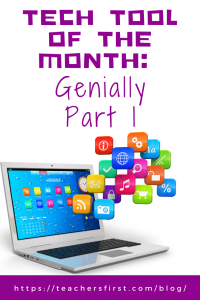Genially is a multimedia tool that creates impressive presentations, videos, games, infographics, interactive posters, social media images, and many others. Choose the type of project you want to create and view the many templates that are ready to go. Nearly all of the templates are free; however, the templates marked with a gold star are only available with a premium membership. Instructions are given to help you to create your project. You can edit their large selection of ready-to-go templates, delete the items you don’t want to use, or add your own slides, images, and other media. When you are finished with your project, you have the option to download or share via URL, embed, or email.
Applying the Triple E Framework
The Triple E Framework, created by Dr. Liz Kolb, is built on the belief that “effective technology integration begins with good instructional strategies and not fancy tools” (tripleeframework.com). Dr. Kolb wrote a book on Learning First, Technology Second (ISTE, 2017) that lays out the three main uses for technology in education: to Engage, Enhance, or Extend learning goals. We can use this framework to decipher why we are using specific tools in the classroom. Here is a rubric based on the Triple E Framework you can use to evaluate whether Genially (or any other technology) is a good fit with your learning goals and whether you should use it in your lesson.
- Engage in learning goals: When students are viewing teacher-created Genially projects, the students are more focused on the task because they are working at their own pace and using/viewing the video or other media. There are no badges, games, or other extras to distract from the process of learning. When students are creating their own projects using Genially, students are more focused on the task because they can easily create images, videos, and other media that represent content learning goals (for example, sharing a video related to a literary piece recently read in class). Genially motivates students to begin the learning process since they get to make decisions and are actively involved in choosing what to include in the media project.
- Enhance learning goals: With younger students, using Genially as a consumer (and viewing projects created by the teacher), videos and other media allow students to use technology to make connections to understand concepts and ideas. Students old enough to create their own Genially can enhance their learning goals because it allows students to share concepts, questions, and information. The media creations allow students to assess their comprehension and to demonstrate a more sophisticated understanding of the topic by creating their own original work. Students are using higher-order thinking skills to organize their thoughts and words for the video, poster, or other presentation. Creativity is also included as they have the option to add lots of features such as images, videos, text, and more.
- Extend learning goals: Dr. Kolb describes extended learning as an opportunity for students to learn, connect, and collaborate outside of the regular school day and as a bridge between the school day and real-life experiences. Whether students are using this tool to view media created by teachers or creating their own media, Genially works well outside of the classroom and would fit in well with flipped, blended, and remote learning. Students could also work collaboratively in class, working in small groups would be a very purposeful choice, as fewer devices would be required, and students could work together through the steps of viewing or creating the project. We are preparing our students for a world that doesn’t exist yet, but most jobs do require independent motivation and knowledge of technology. Genially allows students to practice skills they will use in the future, as many classes and careers require students to use technology and to curate and review work-related projects.
SAMR Connection
The SAMR Model, by Dr. Ruben Puentedura, suggests that technology implementation has four levels. We can use this model as a guideline to analyze how we’re using technology tools in the classroom. Depending on how they are used, Tasks created with Genially can be at the level of Augmentation, Modification, or Redefinition.
- Augmentation: At the level of augmentation, the technology acts as a direct substitute but also includes some functional improvements. Genially could be at the level of augmentation by sharing a video presentation with students. This provides some functional improvements because students are able to rewatch the video as often as needed to increase understanding.
- Modification: The level of modification allows us to make (or modify) the activity into something more integrated with technology, meaning there is significant task redesign. There are many ways that creating projects using Genially could reach the level of Modification with students old enough to create their own projects. For example, rather than students viewing a teacher-created video (as listed under Augmentation), students could now create their own video. This could not be done without technology.
- Redefinition: The highest level of SAMR could be reached by sharing students’ final videos (or a different project) and offering feedback to others. Students could also add additional audio and other multi-media options to redefine the final project. Once the videos or other projects are created, have individuals (or cooperative learning groups) share the URLs to their projects with the class. The teacher could also share the URLs on the class website for students (and families) to view.
Don’t miss Part 2 of the Tech Tool of the Month: Genially, where we’ll discuss how to use the tool and classroom use ideas by subject. In the meantime, let us know how you have used Genially in your education setting in the comment section below.


